 Composer: Joseph Haydn
Composer: Joseph Haydn
Works: String Quartets Op. 64, Nos. 1, 2, 3
Performers: The Lindsays: Peter Cropper, violin; Roland Birks, violin; Robin Ireland, viola; Bernard Gregor-Smith, cello
Recording: September 1999, Holy Trinity Church, Wentworth, England
Label: ASV CD DCA 1083
Joseph Haydn’s String Quartets Op. 64, composed between 1787 and 1790, stand as a testament to his mastery during a fertile artistic period. These quartets emerged as part of a larger corpus that saw Haydn refining the string quartet genre, a form he would significantly shape. The Op. 64 quartets, particularly praised by Haydn scholar H.C. Robbins Landon as “perhaps Haydn’s single greatest achievement of the period,” encapsulate the composer’s ability to balance intellectual rigor with lyrical beauty, making them essential listening for any serious chamber music aficionado.
The Lindsays, an ensemble renowned for their insightful interpretations of string quartet literature, deliver a compelling performance that captures the essence of these works. In the String Quartet in C, Op. 64, No. 1, the opening Allegro moderato is infused with buoyant energy and rhythmic clarity, allowing Haydn’s thematic material to unfold with a natural grace. The ensemble’s approach to the dynamics—moving seamlessly from robust fortissimos to delicate pianissimos—illustrates their understanding of Haydn’s nuanced musical language. The second quartet, in B minor, presents a more introspective character, especially in the Adagio ma non troppo, where the Lindsays’ attention to phrasing and tonal shading evokes a profound sense of melancholy, highlighting Haydn’s emotional depth.
Technical execution throughout the recording is commendable, with each player demonstrating a refined technique and a deep ensemble cohesion. The interplay between the violins in the vivacious Vivace assai of the third quartet showcases a spirited dialogue, full of animated exchanges that reflect Haydn’s wit and charm. However, at times, the recording’s engineering seems to obscure individual instrumental lines, particularly in the denser textures of the slower movements. A more pronounced separation of the instruments could enhance listeners’ ability to appreciate the intricate counterpoint that Haydn expertly weaves.
In comparison with other notable recordings, such as the acclaimed performances by the Hagen Quartet or the Alban Berg Quartet, The Lindsays provide a fresh perspective that is both engaging and distinctive. Their interpretations, while not as overtly dramatic as some peers, reveal an understated elegance that aligns with Haydn’s aesthetic. The subtle interplay of voices and the affectionate phrasing employed by The Lindsays resonate deeply, allowing the music’s inherent humor and pathos to shine through.
This recording of Haydn’s Op. 64 quartets is a testament to the enduring relevance of his music and the interpretative skill of The Lindsays. Their performance brings to life the rich tapestry of Haydn’s compositional ingenuity, offering both charm and gravitas. Despite minor reservations regarding the clarity of sound at times, the overall execution and interpretative insight affirm The Lindsays’ status as a leading ensemble, making this recording a valuable addition to the Haydn discography.



